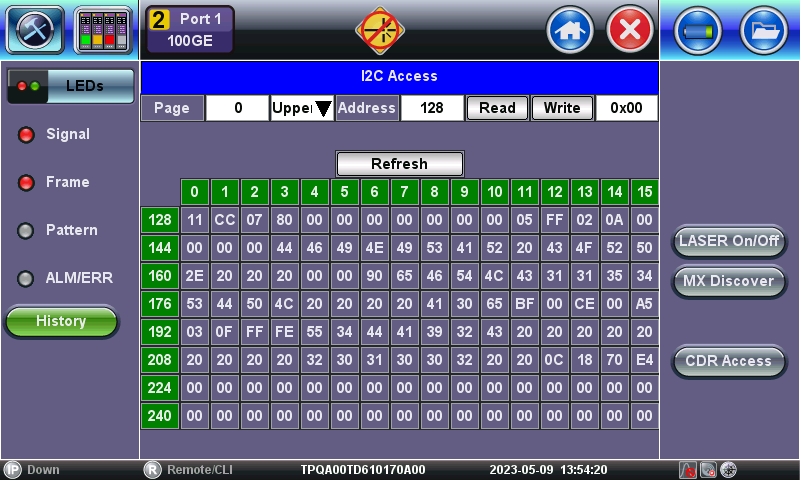What are I2C, MDIO and CMIS Access in Optical Transceivers?
Allows access to optical transceivers' register pages (memory map) to Read their status and Write (program) their configurations.
Often referred as I²C, I2C, IIC (Inter-Integrated Circuit), MDIO (Management Data Input/Output) or CMIS (Common Management Interface Specification), these serial bus management interfaces provide direct access to the internal memory map of optical transceivers (e.g., SFPx, QSFPx, OSFP), which contains important settings, status and information about the device. The meaning of each page and bytes are defined by MSA (Multi-Source/Supplier industry Agreement) standards like SFF-8636 or OIF's CMIS.
Here is an example of one of the VeEX's transceiver registers access and programming features (RXT feature named I2C Access):

DO NOT change any of these bytes, unless you are considered an expert or knowledgeable of the subject. Refer to the memory map standards for the meaning of each byte and their appropriate values.
Modern QSFP-DDx and CFP2-DCO transceivers may support multiple internal modes of operations (application selection or AppSel) that need to be properly programmed and read, using CMIS, to ensure compatibility. Advanced T&M products, like VeEX's MPA and RXT platforms, allow users to confirm the current operation mode of a transceiver and reprogram it if necessary. The example below shows the 400GE and 4x100GE capabilities of a 400G QSFP-DD DR4 transceiver.

Coherent transceivers offer even more flexibility in terms of modes of operation. Reading and decoding their register become very important to understand how it is programmed, as well as allowing to reprogram them to match the application.
Related Standards
- INF-8074 SFP (Small Formfactor Pluggable) Transceiver
- INF-8438 QSFP (Quad Small Formfactor Pluggable) Transceiver
- OIF-CMIS Common Management Interface Specification
- REF-TA-1011 Cross Reference to Select SFF Connectors and Modules
- SFF-8024 SFF Module Management Reference Code Tables
- SFF-8079 SFP Rate and Application Selection
- SFF-8418 SFP+ 10 Gbit/s Electrical Interface
- SFF-8419 SFP+ Power and Low Speed Interface
- SFF-8431 SFP+ 10 Gbit/s and Low Speed Electrical Interface (replaced by SFF-8418 and SFF-8419)
- SFF-8436 QSFP+ 10 Gbit/s 4X Pluggable Transceiver
- SFF-8449 Management Interface for SAS Shielded Cables
- SFF-8472 Management Interface for SFP+
- SFF-8636 Management Interface for 4-lane Modules and Cables
- SFF-8665 QSFP+ 28 Gbit/s 4X Pluggable Transceiver Solution (QSFP28)
- SFF-8679 QSFP+ 4X Hardware and Electrical Specification
- SFF-8690 Tunable SFP+ Memory Map for ITU Frequencies
Related Test Solutions
- MPA Advanced Multi-Protocol Modular Test Platform up to 400G
- RXT-6402 Advanced Multi-Service 2x400G Test Module
- RXT-6400 Multi-Service 400G Test Module
- RXT-6200+ Advanced Multi-service Test Module up to 2x100G
- RXT-3400 Advanced Multi-service Test Set up to 16G
- TX300s-100Gx Advanced Multi-service Test Set up to 100G
- TX340s Advanced Multi-Service Test Set up to 16G
- MTTplus-340 Advanced Multi-Service Test Module
- RTU-300 Centralized Modular Test Platform
- RTU-320 & RTU-600x Remote Test Unit/Ethernet/IP Test Module
